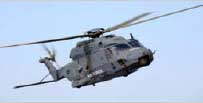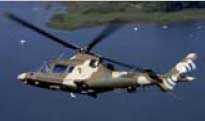Medium Utility Helicopter and Training/Light Utility Helicopter

 Project purpose and history
Project purpose and history
The purpose of these projects is to replace 14 Iroquois helicopters with eight NH90 Medium Utility Helicopters, and replace the Sioux helicopters with five Agusta-Westland A109 Training/Light Utility Helicopters and a flight simulator. Unlike the rest of the report, we have grouped the Medium Utility and Training/Light Utility Helicopter projects in this section. The two helicopter types are part of the same project - NZDF Helicopter Capability. However, the two types had separate references in the 2006 LTDP, and have followed different acquisition paths and timing. We reflect here the shared history of the helicopters, and the rest of the report shows their progress as separate parts of the combined project.
Since the mid-1960s, a fleet of 14 Bell UH-1H Iroquois aircraft have provided the utility helicopter capabilities of the NZDF. Five Bell B47G Sioux aircraft have provided helicopter training requirements. After more than 40 years' service, both types of helicopter are approaching or are at the limits of safe and economic operation. Neither type can meet the NZDF's current and future helicopter requirements, which include:
- lifting heavier loads over longer distances;
- operating in adverse weather and at night; and
- providing lead-in training for both the new Medium Utility helicopter and the Seasprite SH 2G operated by the Royal New Zealand Navy.
On 3 December 2003, Cabinet approved the Ministry going to the industry to explore options for both the Medium Utility Helicopter and the Training/Light Utility Helicopter capabilities. At that point, the capabilities were estimated to cost between $400 million and $550 million for the Medium Utility Helicopters and $11 million for the Training/Light Utility Helicopters.
A contract for the acquisition of eight NH90 Medium Utility helicopters, spares (including another airframe for parts), and training was signed on 31 July 2006 (see the Ministry's Annual Report for 2006, page 37).
On 30 October 2007, the Minister of Defence announced that Cabinet had approved the start of contract negotiations for five Agusta-Westland A109 Training/Light Utility Helicopters and a flight simulator to meet the NZDF's requirements. A contract was signed on 8 May 2008.
The tables below for the Training/Light Utility Helicopter project show the changes in costs and time frames between the Approval to Commence and Approval to Commit points only. This is because, unlike the other selected projects, this project's Approval to Commit came after the Ministry's December 2007 report to the Committee.
Cost and time frame changes for the Medium Utility Helicopter
Costs and time frames at the Approval to Commence and Approval to Commit points, and figures forecast as at December 2007
| Approval to Commence point | Approval to Commit point | Ministry's December 2007 forecast to the Committee | |
|---|---|---|---|
| Cost (excluding GST) |
$400m to $550m 1 | $771.7m 2 | $771.7m |
| Time frame | Around 2007 3 | All deliveries by mid-2011 | All helicopters by mid-2011 |
Sources
- We use the range from the Cabinet approval of 3 December 2003, which cited the 2003 LTDP. When the Ministry reported to the Committee in December 2007, it used the 2004 LTDP range ($400 million to $550 million) for both the Medium Utility Helicopter and Training/Light Utility Helicopter.
- We use the cost in the contract, which was signed on 31 July 2006.
- We use the 2003 LTDP because no time frame was given in the Cabinet approval.
Changes to costs and time frames as the project has progressed
| Approval to Commence point to Approval to Commit point | Approval to Commit point to the Ministry's December 2007 forecast | Total change between the Approval to Commence point and the Ministry's forecast | |
|---|---|---|---|
| Cost (excluding GST) |
+$221.7m 1 | 0 | +$221.7m |
| Time (months) | +42 2 | 0 | +42 |
Explanatory notes
- This is the difference between the upper limit of the estimated range at the Approval to Commence point ($550 million) and the Approval to Commit point ($771.7 million).
- This is the difference between the Approval to Commence point (around 2007 - so we have assumed that this means the end of 2007) and the Approval to Commit point (mid-2011 - so we have assumed that this means the end of June 2011).
Cost and time frame changes for the Training/Light Utility Helicopter
Costs and time frames at the Approval to Commence and Approval to Commit points
| Approval to Commence point | Approval to Commit point | |
|---|---|---|
| Cost (excluding GST) |
$110m 1 | 139.3m 3 |
| Time frame | During 2008 2 | Enter into service in 2011 4 |
Sources
- We use the figure from the Cabinet approval of 4 September 2006. We note the significant increase in the defence agencies' estimate of cost between the 2002 and 2006 LTDPs (an increase of $99 million, from $11 million to $110 million). The defence agencies advised that the estimate in the 2002 LTDP was based on an "off-the-shelf" civil helicopter. The 2006 LTDP estimate was informed by technical changes to the Medium Utility Helicopter project that meant that an "off-the-shelf" civil helicopter would no longer meet the NZDF's training needs, and that a militarised helicopter would be sought at additional cost. Cabinet noted that the $110 million figure was an approximate cost, subject to confirmation after further discussions with manufacturers and suppliers.
- We use the figure from the 2006 LTDP because there was no indication of timing in the Cabinet approval.
- We use the approval signed by the Ministers of Defence and Finance (Joint Ministers) on 29 and 30 April 2008 respectively, as authorised by Cabinet.
- We use the Minister of Defence's press release marking the signing of the contract on 8 May 2008. This is because there was no indication of timing in the Joint Ministers' approval.
Changes to costs and time frames as the project has progressed
| Approval to Commence to Approval to Commit points | |
|---|---|
| Cost (excluding GST) |
+$29.3m 1 |
| Time (months) | +36 2 |
Explanatory notes
- This is the difference between the Approval to Commence point ($110 million) and the Approval to Commit point ($139.3 million).
- This is the difference between the Approval to Commence point (during 2008 - so we have assumed that this means the end of 2008) and the Approval to Commit point (enter into service in 2011 - so we have assumed that this means the end of 2011).
